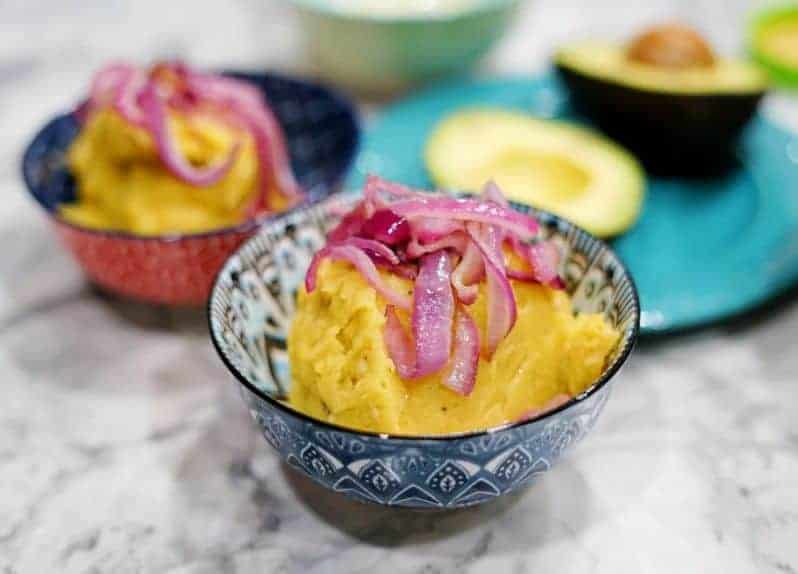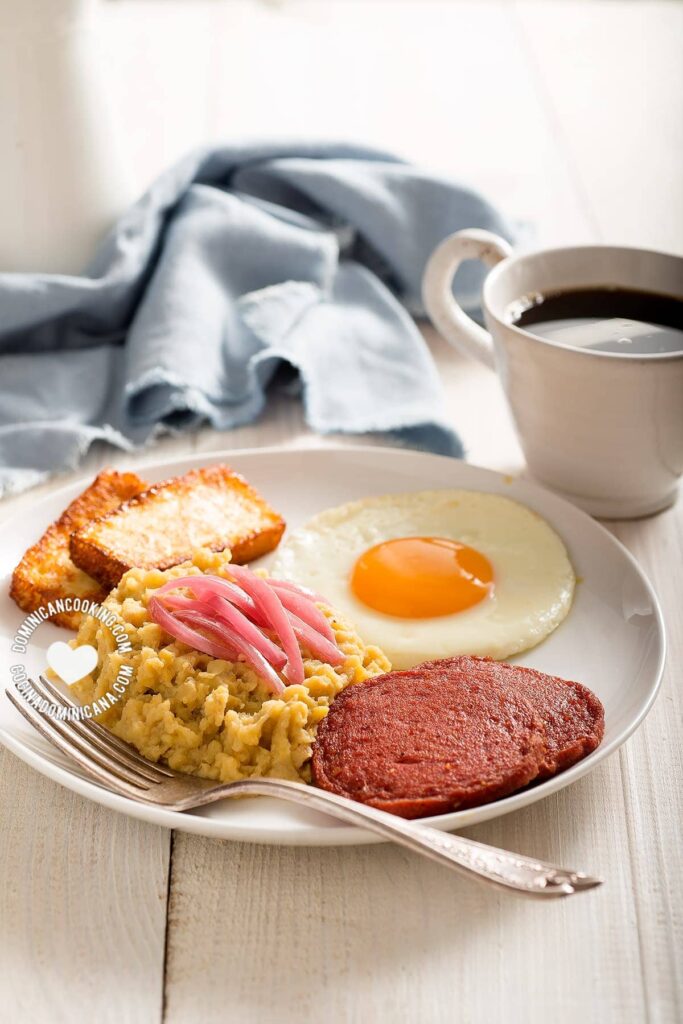Mangu, the quintessential comfort food of the Dominican Republic, stands as a testament to the island’s rich culinary heritage. This dish, a simple concoction of mashed plantains, brings warmth to the dining table, embodying the spirit of Dominican hospitality. Originating from the need to create a hearty meal from humble ingredients, Mangu has evolved into a national symbol cherished across generations.

The preparation of Mangu is an art in itself, transforming the starchy green plantains into a creamy, smooth delight. It’s a versatile dish, often gracing breakfast tables alongside fried eggs, cheese, and salami, yet it’s substantial enough to serve as a satisfying side for any meal. In this article, we’ll walk you through the history, cultural significance, and step-by-step creation of this Dominican recipes Mangu.
What is Mangu?
Mangu is a cornerstone of Dominican cuisine, a dish that captures the essence of the island’s gastronomic traditions. At its core, Mangu is a hearty, mashed plantain dish, often served as a staple breakfast but versatile enough for any meal. The name itself has roots in African languages, reflecting the rich cultural tapestry of the Dominican Republic.

The dish begins with green plantains, chosen for their firmness and starchiness, which are boiled until tender. Once cooked, these plantains are mashed, traditionally with a bit of the water they were boiled in, which helps to create a creamy consistency. To this, a generous helping of oil or butter is added, enriching the flavor and texture of the Mangu.
Mangu’s simplicity is deceptive; it’s a canvas for a variety of flavors. It’s commonly topped with sautéed red onions, adding a sweet and tangy contrast to the earthy plantains. This balance of flavors is what makes Mangu not just a dish but an experience, one that is deeply embedded in the Dominican way of life.
The preparation of Mangu is more than just a culinary process; it’s a ritual that brings families together, a symbol of home. It’s a dish that has traveled through time, from the fields of the Congo to the heart of the Caribbean, evolving with each generation while maintaining its soulful simplicity. Mangu isn’t just food; it’s a story on a plate, a taste of history, and a testament to the Dominican spirit.
Dominican recipes mangu: A Step-by-Step Guide
Selecting the Right Plantains
The journey to a perfect Mangu begins with the selection of plantains. Green plantains are the star of this dish, chosen for their firm texture and mild flavor. Look for plantains that are heavy for their size, unblemished, and uniformly green. These will yield the starchy base that’s essential for a traditional Mangu.

The Boiling Process
Once you’ve selected your plantains, it’s time to boil them. Start by cutting off the ends and making a slit along the side to make peeling easier after they’re cooked. Place the plantains in a pot of salted water, ensuring they’re completely submerged. Bring the water to a boil, then reduce the heat and let them simmer. The plantains are ready when they’re tender, which typically takes about 20 minutes.

The Art of Mashing
After boiling, the plantains should be drained, but a cup of cooking water should be reserved. While still warm, peel the plantains and return them to the pot. Now, the mashing begins. Using a fork or a potato masher, work the plantains to achieve a smooth consistency.
If the mixture is too thick, add a bit of the reserved water to reach the desired creaminess. During this step, a generous dollop of butter or a swirl of oil is added, which not only enriches the flavor but also gives Mangu its signature velvety texture.

Flavoring with Onions
No Mangu is complete without its signature topping: sautéed red onions. Thinly slice the onions and cook them in a pan with a splash of vinegar and a pinch of salt until they’re soft and translucent. This simple yet flavorful addition provides a sweet and tangy contrast that elevates the dish.

Final Touches
With the plantains mashed and the onions ready, it’s time to assemble the dish. Serve the Mangu warm, topped with the sautéed onions. For an authentic Dominican experience, pair it with fried eggs, cheese, and salami, known as ‘Los Tres Golpes.’ This combination is not only delicious but also provides a balanced meal to start the day.

Serving Suggestions: Complementing Your Mangu
Mangu, a beloved dish from the Dominican Republic, is not only about its rich, creamy texture and the subtle flavors of the plantains. It’s also about the accompaniments that turn it into a complete meal. Here are some traditional and modern ways to serve Mangu that will satisfy both purists and adventurers alike.
Traditional Accompaniments
In the Dominican Republic, Mangu is traditionally served with ‘Los Tres Golpes’—the three hits. This trio includes fried eggs, fried salami, and fried cheese, creating a balance of protein and fat that complements the starchy base of the Mangu.
The eggs are usually fried sunny-side up, the salami is sliced and crisped to perfection, and the cheese, often a firm, salty variety like queso de freír, is fried until it boasts a golden crust with a soft, melted interior.

Modern Twists
For those looking to experiment, Mangu can be a blank canvas for a variety of flavors. Avocado slices add a buttery texture and a hint of freshness to the dish. For a healthier twist, olive oil can be used in place of traditional butter, and for vegans, plant-based butter or oils are excellent substitutes. Some chefs like to add a sprinkle of freshly chopped cilantro or a dash of hot sauce for an extra kick.

The Nutritional Aspect
Mangu is rich in complex carbohydrates and provides a good source of dietary fiber, especially when made with green plantains. It’s also a dish high in potassium and vitamins, particularly vitamin C and vitamin A. While the traditional accompaniments can be high in fat, they can be modified for a lighter meal without sacrificing flavor. For instance, the eggs can be poached instead of fried, and low-fat cheese can replace the traditional varieties.
A Dish for All Times
Whether it’s served for breakfast to start the day with energy, as a hearty lunch, or as a comforting dinner, Mangu is versatile. It’s a dish that invites creativity and can be adapted to suit any taste or dietary preference. The key is to maintain the essence of Mangu while making it your own.
Nutritional Profile of Mangu
Mangu, a staple in Dominican cuisine, is not only cherished for its comforting taste but also for its nutritional benefits. Made from green plantains, Mangu is a wholesome dish that provides essential nutrients vital for a balanced diet.
Green plantains, the primary ingredient in Mangu, are a rich source of complex carbohydrates, which are crucial for sustained energy throughout the day.
Unlike their ripe counterparts, green plantains have a lower sugar content, making them an excellent option for those monitoring their sugar intake.

In terms of vitamins and minerals, plantains are an excellent source of vitamin C, which is important for immune system function, and vitamin A, which is essential for healthy vision and skin. They also provide a good amount of potassium, which is necessary for maintaining proper heart function and muscle contractions.
Mangu’s nutritional profile can be further enhanced by its traditional toppings. The onions, often sautéed and served on top, contribute additional vitamins and antioxidants.
When paired with ‘Los Tres Golpes’—fried eggs, cheese, and salami—the dish becomes a protein-rich meal, although it’s worth noting that these additions also increase the fat content.
For those looking for a lighter version of Mangu, there are several ways to adjust the recipe. Using less oil or butter in the preparation can reduce the fat content, and opting for healthier sides like avocado or sautéed vegetables can make it a more nutritious meal.

Final Analysis
Mangu is more than just a dish; it’s a cultural emblem of the Dominican Republic, a culinary tradition that has been lovingly passed down through generations. It embodies the simplicity and resourcefulness of Dominican cooking, turning the humble plantain into a comforting and nourishing meal that is enjoyed by families across the island.
Mangu’s versatility and nutritional value have made it a beloved staple, adaptable to various tastes and dietary needs. Whether served in its traditional form with ‘Los Tres Golpes’ or customized with modern twists, Mangu remains a testament to the rich tapestry of flavors that define Dominican cuisine.
As we’ve explored the different facets of Dominican recipes mangu—from its origins and preparation to its regional variations—we’ve seen how this dish reflects the history, culture, and heart of the Dominican people. It’s a story of community, connection, and the joy of sharing good food.








3 Comments